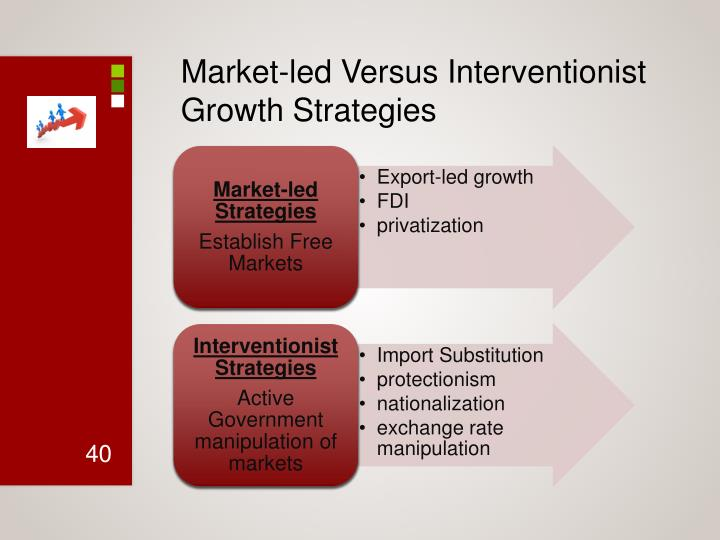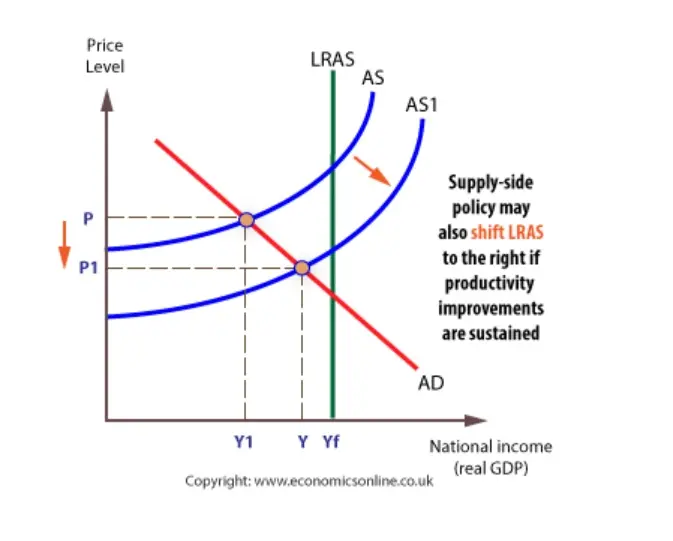AQA Specification focus:
‘Students should be able to compare market-based strategies and interventionist strategies for promoting growth and development.’
Introduction
Market-based and interventionist strategies represent contrasting economic approaches to promoting economic growth and development. Understanding their mechanisms, strengths, and limitations is crucial for analysing policy decisions in both developed and developing economies.
Market-Based Strategies
Market-based strategies aim to promote growth by reducing government intervention, encouraging competition, and allowing the free market to allocate resources efficiently. These strategies align with neoclassical economic theory, which emphasises the efficiency of market forces in achieving optimal outcomes.
Key Features
Reliance on private sector investment to drive innovation and productivity.
Reduction of trade barriers and deregulation to encourage competition.
Lower taxation to incentivise enterprise and investment.
Emphasis on property rights to ensure security for investors and entrepreneurs.
Market-Based Strategy: An economic policy approach that prioritises the role of free markets and private enterprise over state intervention in achieving growth and development.
Types of Market-Based Policies
Trade Liberalisation
Removing tariffs, quotas, and subsidies to allow comparative advantage to operate, improving efficiency and global integration.Privatisation
Selling state-owned enterprises to private firms to increase efficiency through profit motives and competition.Deregulation
Reducing government-imposed restrictions in markets (e.g., labour and financial markets) to increase competition and productivity.Tax Reforms
Lowering marginal tax rates to encourage work, saving, and investment.Labour Market Reforms
Enhancing labour flexibility, reducing minimum wage constraints, and making it easier to hire and fire workers.Financial Sector Liberalisation
Allowing greater foreign investment in banking and capital markets to increase access to finance.
Advantages of Market-Based Strategies
Efficient Resource Allocation: Prices reflect scarcity, guiding resources to their most productive uses.
Innovation and Entrepreneurship: Competitive markets encourage firms to innovate.
Fiscal Savings: Reducing subsidies and state spending frees resources for infrastructure and education.
Foreign Direct Investment (FDI): Liberalisation and openness attract multinational corporations (MNCs), boosting capital inflows.
Disadvantages of Market-Based Strategies
Income Inequality: Market forces can widen income gaps as wealth concentrates among capital owners.
Market Failures: Markets may underprovide public goods or ignore externalities like pollution.
Short-Term Unemployment: Deregulation and privatisation can lead to job losses during economic restructuring.
Vulnerability to External Shocks: Greater openness exposes economies to global financial volatility.

This diagram illustrates the fundamental differences between market-led and interventionist growth strategies. Market-led strategies focus on establishing free markets, promoting export-led growth, and encouraging foreign direct investment (FDI) through privatisation. In contrast, interventionist strategies involve active government intervention, such as import substitution, protectionism, and exchange rate manipulation, to stimulate economic development. Source
Interventionist Strategies
Interventionist strategies involve active government involvement to correct market failures, promote equity, and accelerate development. They are grounded in Keynesian and structuralist economic theories, which argue that markets alone cannot ensure long-term sustainable growth, especially in developing economies.
Key Features
Government plays a central role in planning and regulation.
Policies focus on public investment in infrastructure, education, and healthcare.
Protection and support for infant industries.
Use of fiscal and monetary policy to stabilise demand and investment.
Interventionist Strategy: A policy approach in which the government plays an active role in managing the economy to achieve growth, correct market failures, and promote development.
Types of Interventionist Policies
Public Sector Investment
Funding infrastructure such as roads, ports, and power supply to improve productivity and attract private investment.Education and Training
Enhancing human capital to increase labour productivity and innovation.Healthcare Provision
Improving workforce health to reduce absenteeism and enhance productivity.Industrial Policy
Supporting strategic industries through subsidies or tax incentives to promote diversification and technological advancement.Exchange Rate Management
Maintaining competitive exchange rates to support exports and reduce balance of payments deficits.Research and Development (R&D) Support
Providing grants or incentives to encourage innovation and technological progress.
Advantages of Interventionist Strategies
Addresses Market Failures: Ensures provision of public goods and correction of externalities.
Improves Equity: Public spending and progressive taxation reduce inequality.
Enhances Long-Term Capacity: Investments in education and infrastructure create the foundation for sustained growth.
Stabilises the Economy: Government spending can offset private sector volatility during recessions.

The diagram shows the effect of interventionist supply-side policies on the economy. By investing in infrastructure, education, and technology, the government can shift the LRAS curve to the right, leading to increased potential output and long-term economic growth. This illustrates the government's role in directly influencing the economy's productive capacity. Source
Disadvantages of Interventionist Strategies
Inefficiency and Bureaucracy: Government decisions may be less efficient than market mechanisms.
Corruption and Misallocation: Political influence can distort resource allocation.
Fiscal Burden: High public spending can lead to budget deficits and debt accumulation.
Crowding Out: Public sector borrowing may limit funds available for private investment.
Comparing Market-Based and Interventionist Strategies
Core Distinctions
Market-Based Strategies involve minimal government interference and rely primarily on private sector competition and open markets to drive growth. Interventionist Strategies, on the other hand, depend on significant government planning, public investment, and regulation to guide economic activity.
Market-Based Approaches emphasise deregulation, privatisation, and free trade, while Interventionist Approaches stress the importance of education, healthcare, and infrastructure development. Each has distinct advantages: market-based policies enhance efficiency and innovation, whereas interventionist policies promote equity and stability.
Economic Development: A process involving qualitative improvements in living standards, health, education, and income distribution, not just increases in GDP.
Complementarity Between Strategies
In practice, most governments adopt a mixed approach, combining market-based efficiency with interventionist equity.
Examples include:
East Asian economies (e.g., South Korea, Singapore): Used export-oriented growth (market-based) alongside state-led industrial policy (interventionist).
Western economies: Use fiscal stimulus during downturns while maintaining liberalised markets during expansions.
When Each Approach Is More Effective
Market-Based Policies are often more effective in developed economies with strong institutions and functioning markets.
Interventionist Policies tend to be more suitable for developing countries with structural weaknesses, poor infrastructure, or inadequate human capital.
Evaluating Policy Effectiveness
Criteria for Assessment
Sustainability: Whether growth can be maintained without excessive borrowing or resource depletion.
Inclusivity: The extent to which benefits are shared across society.
Institutional Quality: Corruption, governance, and legal systems affect outcomes.
External Conditions: Global demand, commodity prices, and trade relations influence success.
Sustainable Development: Economic growth that meets the needs of the present without compromising the ability of future generations to meet their own needs.
Both strategies aim to promote development, but their success depends on how well they are adapted to the specific context of an economy’s structure, stage of development, and institutional capacity.
FAQ
Governments and economists assess the success of these strategies through indicators such as GDP growth rates, productivity improvements, employment levels, and income inequality.
For interventionist strategies, improvements in education, infrastructure quality, and healthcare outcomes also signal effectiveness. In contrast, for market-based strategies, rising levels of private investment, export growth, and innovation are key markers of success.
Market-based strategies often lead to greater income inequality because they reward productivity and capital ownership. Those with assets, education, or skills benefit most from liberalised markets.
However, governments can mitigate inequality by introducing complementary policies such as progressive taxation or targeted welfare programmes while maintaining a largely market-oriented structure.
Developing economies often face structural weaknesses, including poor infrastructure, weak legal systems, and corruption, which hinder the efficient functioning of markets.
They may also lack financial depth and face volatile capital flows, reducing the benefits of liberalisation. As a result, market-based policies may require prior institutional strengthening to be effective.
When subsidies, price controls, or state ownership become entrenched, firms may rely on government protection instead of improving efficiency.
This can occur in economies where political incentives favour maintaining uncompetitive industries. Over time, such dependency discourages innovation and creates fiscal pressure from ongoing public spending.
A balanced combination allows governments to correct market failures while still harnessing private sector efficiency.
For example:
The state can invest in education and infrastructure to enhance human capital.
Market incentives can then drive innovation and efficient resource allocation.
This synergy helps create inclusive, sustainable growth that neither strategy could achieve alone.
Practice Questions
Explain one reason why a government might prefer to use interventionist strategies instead of market-based strategies to promote economic development. (3 marks)
1 mark for identifying a valid reason (e.g., to correct market failure or reduce inequality).
1 mark for briefly explaining how this reason relates to economic development.
1 mark for applying the explanation to an example (e.g., government investment in education to improve human capital).
Discuss the advantages and disadvantages of using market-based strategies to achieve economic growth in developing economies. (6 marks)
Up to 2 marks for identifying valid advantages (e.g., efficiency, innovation, attraction of FDI).
Up to 2 marks for identifying valid disadvantages (e.g., inequality, vulnerability to external shocks).
1 mark for developing each point with clear economic reasoning.
1 mark for evaluative comment or balance (e.g., noting that effectiveness depends on the strength of institutions and infrastructure in the economy).

